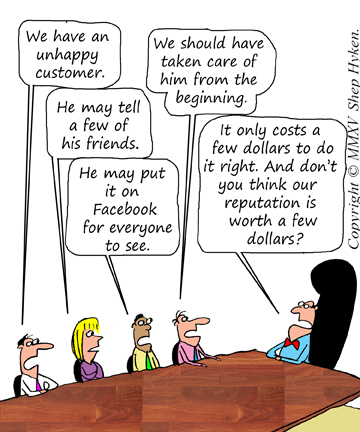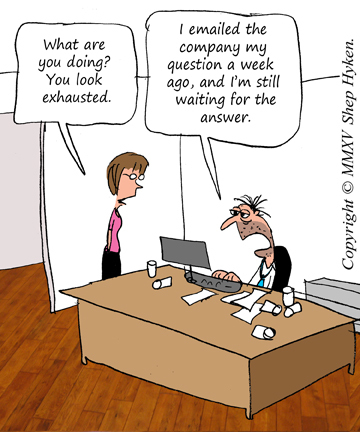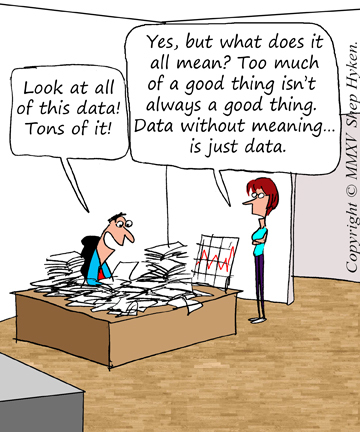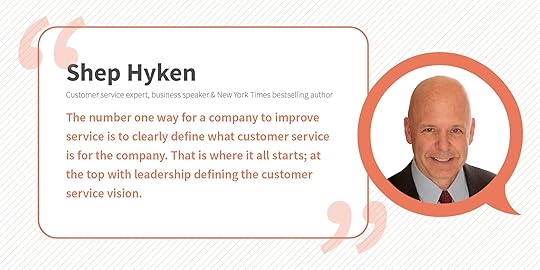Shep Hyken's Blog, page 200
November 18, 2015
How Much is Your Reputation Worth?
 Recently I wrote about how Delta Airlines and an employee at the St. Louis airport perfectly handled my dilemma in getting to a speaking engagement on time. There were some great lessons in that story, but there is another lesson that is just as powerful, if not more so.
Recently I wrote about how Delta Airlines and an employee at the St. Louis airport perfectly handled my dilemma in getting to a speaking engagement on time. There were some great lessons in that story, but there is another lesson that is just as powerful, if not more so.
My client expected me to show up. They promoted the event and had 200 people that were expecting me to present my customer service presentation. What kind of message would I be sending the client and the audience if I failed to show up – or at least make somewhat of a heroic effort to do so?
Basically, because of a mechanical problem on the plane, I was going to miss my connection to speech. Even with contingency planning with back-up flights, it looked I could possibly be a “no show.” The only solution was a private jet. That cost thousands of dollars, but, what is my reputation worth?
If I didn’t show up, would the client ever hire me again? Would they tell others in the industry about the speaker who didn’t show up? What about the audience members? Would they tell their colleagues? How would this impact my reputation?
In the future, there may problems that are truly beyond my control that prevent me from getting to a speech on time. That said, the client will know that I will do my very best and exhaust all possibilities to be there.
It doesn’t have to cost thousands of dollars to save a reputation. Maybe it’s just a few dollars? I’m amazed at how many companies don’t think about the consequences of letting their customers down, especially when the situation can be saved by just providing better customer service.
Maybe a customer tried to return something to a store without a receipt and salesperson wouldn’t refund or exchange the item, even though the item was new and it was obvious that it came from that store. Or, maybe a manufacturer left something out of their customer’s order and refused to overnight the missing part.
In both of these examples, the company risks losing the customer, but there is even more at stake. As mentioned in the example with my client, people talk. Maybe the customer will tell their colleagues. Maybe the customer will go “social” and complain about the company on Twitter, Facebook or some other social media channel.
Would taking back or exchanging an unused item or spending an extra few dollars to overnight a part to a customer be worth keeping a complaint out of social media? I think so!
So, what’s your reputation worth? A potentially tainted reputation that can be saved by providing a little better customer service or spending a few dollars (or sometimes more than a few dollars) may be exactly what not only saves your reputation, but makes your reputation – a reputation that has your customers talking about how you and your company delivers amazing customer service.
Shep Hyken is a customer service expert, keynote speaker and New York Times bestselling business author. For information contact or www.hyken.com. For information on The Customer Focus™ customer service training programs go to www.thecustomerfocus.com. Follow on Twitter: @Hyken
(Copyright © MMXV, Shep Hyken)
The post How Much is Your Reputation Worth? appeared first on Shep Hyken.
November 16, 2015
5 Top Customer Service Articles For the Week of November 16, 2015
TOP CUSTOMER SERVICE AND BUSINESS ARTICLES
Each week I read a number of customer service articles from various online resources. Here are my top five picks from last week. I have added my comment about each article and would like to hear what you think too.
18 Reasons to Map Customer Journeys by Annette Franz
(CX Journey) Have you started journey mapping yet? Or are you still wondering why it’s an important tool to have in your customer experience management toolbox?
My Comment: Journey Mapping is an important process that every company should go through. This list that is put together by Annette Franz, one of the gurus of Journey Mapping, certainly shares some of the benefits you may have already thought of – and some you haven’t.
What a Great Digital Customer Experience Actually Looks Like by Craig Borowski
(Harvard Business Review) While a strong customer experience has been shown to produce significant results many companies still struggle to identify the plan of action that will best achieve them. This doesn’t have to be the case. Leaders can reach these goals if they focus on something more specific: the digital customer experience.
My Comment: The definition of customer experience has changed from primarily customer service to something that includes every facet of the customer’s experience – well beyond the people-to-people interaction. As we have moved into the digital age, we must recognize the importance of the customers who do business with us (through our website), and never interact with our people. My philosophy has always been that while people do business with people, websites are built by people to be used by people. The digital experience and the human experience need to be consistent.
10 Steps to Creating and Maintaining Insane Customer Loyalty by Ryan Foland
(Techday) Here are 10 variables that when combined into the right equation, can help you solve for insane customer loyalty.
My Comment: I love the title of this article. Who doesn’t want customers to be “insanely” loyal? Great list, and I especially like number two, the “first mover advantage.” While most people might think that is a sales strategy, I’ve been preaching for years that belongs over in customer service and experience.
Why Simple Brands Win by Margaret Molloy
(Harvard Business Review) The greatest brands make life simple. Think Google, Amazon, or even Dunkin’ Donuts. They cut through the clutter by delivering what consumers want, when they want it, without hassle. By simplifying customer experience in a complex world, these brands win customer loyalty, which drives business results and creates value for shareholders.
My Comment: I have to agree that the best brands are simple and easy to do business with. The companies mentioned in this article are perfect examples. So, it doesn’t matter what business or industry you’re in, simplicity wins!
So what exactly does Customer Experience (CX) mean? by Jeff Rajeck
(Econsultancy) Customer experience (CX) is one of the leading ways that marketers seek to differentiate their brands these days. But what is CX?
My Comment: As I started to read this article I thought it would be another definition of CX. Instead I was pleasantly surprised that it was about what CX means to a company. Great stats and facts, along with some tips and tactics. Great article!
Shep Hyken is a customer serv ice expert, professional speaker and New York Times bestselling business author. For information contact or www.hyken.com . For information on The Customer Focus™ customer service training programs go to www.thecustomerfocus.com . Follow on Twitter: @Hyken
The post 5 Top Customer Service Articles For the Week of November 16, 2015 appeared first on Shep Hyken.
November 13, 2015
Guest Blog: Here’s The Best Way to Improve Customer Service, According to 63 Experts [INFOGRAPHIC]
This week on our Friends on Friday guest blog post, my colleague Gigi Peccolo shares statistics and expert advice on the best ways to improve customer service. I am honored to be included in the OneReach report. – Shep Hyken
For businesses in any vertical, it’s becoming increasingly important to provide great customer service. Over 90% of customers expect to receive a consistent customer experience across channels, and over 90% of customers who have an effortless service experience with companies will buy from that company again.
So what’s the best way to make sure your customer service is meeting customer needs? Extensive employee training? Providing service across channels? Getting customer feedback?
A recent OneReach report found that the best way to improve customer service is to focus on the employee experience. Of 63 industry influencers interviewed (including this blog’s Shep Hyken), 16 experts said that concentrating on the employee experience was the best way to improve customer service, followed by walking in the customer’s shoes (13 responses) and defining and reviewing service values within the company (11 responses).
But let’s take a look at defining and reviewing service values within the company. Here’s what Shep Hyken had to say about that.
Research from Forrester has found that 90% of customer service decision makers believe good service is essential to their companies’ success. However, it’s important for everyone in your organization, from agents to CEOs, to be aware of what good service is and review those values on a regular basis. After all, over 80% of customers stopped doing business with a company after a bad customer service experience.
But ultimately, as the OneReach report proves, there’s no one way to provide great customer service. Rather, it takes a variety of perspectives and initiatives to make sure companies are delivering the best service possible.
See what some the influencers had to say about the employee engagement in the OneReach infographic below, and don’t forget to check out the rest of the responses on the OneReach blog.
Gigi Peccolo is the Content Manager at OneReach, where she is focused on creating content enabling companies to offer effective, meaningful customer support over text message. Gigi is a skilled writer, researcher, and content editor. She received her BA in Journalism Studies and Spanish from the University of Denver, where she graduated with Distinction in Journalism Studies.
For more articles from Shep Hyken and his guest contributors go to customerserviceblog.com. Read Shep’s latest Forbes Article:
IBM Conference Explains How Data Can Create A Better Customer Experience
The post Guest Blog: Here’s The Best Way to Improve Customer Service, According to 63 Experts [INFOGRAPHIC] appeared first on Shep Hyken.
November 12, 2015
Amazing Business Radio Interview: Rene Vidal And Steve Finkelstein
 November 12: Rene Vidal and Steve Finkelstein Discuss How to Play Smart to Win in Business.
November 12: Rene Vidal and Steve Finkelstein Discuss How to Play Smart to Win in Business.
Shep Hyken talks with Rene Vidal, chief executive officer of Rene Vidal Companies and tennis pro; and Steve Finkelstein, Sr. Partner and co-founder of Experience on Demand, a consultant firm. They are co-authors of “Play Smart to Win in Business: Leadership Lessons from Center Court to Corner Office.” Rene and Steve explain how sports’ winning practices also apply to business.
Click here to listen:
“Focus on the process and not the outcome.” – Rene Vidal
“What am I going to start doing today that’s different?” – Steve Finkelstein
The post Amazing Business Radio Interview: Rene Vidal And Steve Finkelstein appeared first on Shep Hyken.
November 11, 2015
Social Media Response Time, Are You Fast Enough
 Social Customer Service
Social Customer ServiceI knew it was bad, but just didn’t know how bad. I’m talking about the average time it takes for a company to respond, via different social media channels. A recent study put out by Eptica evaluated 500 US retailers’ ability to respond, by asking ten routine questions. The average amount of time it takes for many of these companies to reply is staggeringly disappointing.
Here are a few of the stats and facts:
For email the average response time was 7 hours and 51 minutes!
For Facebook the average response time was one day, 3 hours and 7 minutes!
For Twitter the average response time was one day, 7 hours and 12 minutes!
This is nuts! If I have a problem, and I contact the company, I don’t want to have to wait almost eight hours to get a response. Maybe all I have is a simple question, I’m not even upset or angry. But, due to the frustration of having to wait hours, or even a day or more, for a response; my simple question becomes a customer service debacle.
Is it just me? As it turns out, most customers are a little more tolerant than I am, but they still experience frustration. The Eptica study also polled 1,000 consumers on how long they were willing to wait when they connected with the companies through these channels. While most people are more accepting of the longer wait times; their patience doesn’t last as long as the average company makes them wait. In the case of Facebook and Twitter, they aren’t even close.
77% of consumers won’t wait more than six hours for an email response.
85% of consumers using Facebook expect an answer within six hours.
64% of consumers using Twitter expect a response within an hour.
All this looks like gloom and doom in the world of customer service, but there is good news. Yes, there are some rock stars out there who put others to shame. Some of these great companies respond within a minute or less. But more importantly, this report is a wake-up call for all of us.
Quick response matters! Look at this report and determine which industry you’re in. And, if you feel that B2B doesn’t apply, you’re wrong. Regardless of the industry and the numbers, the concept of quick response is universal. When your customer has a question, they want an answer. When your customer has a problem, they want it resolved. And most don’t want to wait a day or two for you to get back to them.
My suggestion is to take some action. First, download the report, it’s free. Then, take a look at your response times. And consider this, while the response times focus on outside customers, how long do you take to respond to the people you work with, also known as your internal customers? Those are very important customers as well!
(For the “Cliff Notes” version of the study, Eptica has created an infographic of the results.)
Shep Hyken is a customer service expert, keynote speaker and New York Times bestselling business author. For information contact or www.hyken.com. For information on The Customer Focus™ customer service training programs go to www.thecustomerfocus.com. Follow on Twitter: @Hyken
(Copyright © MMXV, Shep Hyken)
The post Social Media Response Time, Are You Fast Enough appeared first on Shep Hyken.
November 9, 2015
5 Top Customer Service Articles For the Week of November 9, 2015
TOP CUSTOMER SERVICE AND BUSINESS ARTICLES
Each week I read a number of customer service articles from various online resources. Here are my top five picks from last week. I have added my comment about each article and would like to hear what you think too.
15 Essential Customer Experience Articles and Resources by Jennifer Winter
(UserTesting) We’ve curated 15 of the top articles and resources to help keep you at the top of your CX game. Dig in and enjoy!
My Comment: I ran across this compilation of 15 customer experience articles. There is something here for just about anyone interested in CX. Everything from some basic information to some advance topics. Definitely worth a look.
Let Empathy Toward Customers Guide You by David Myron
(Destination CRM) An empathetic employee will listen to customers, understand their needs, and be motivated to provide them with the right solution
My Comment: It’s nice when a company gets is right. They have a good product and great service. What can make it better? Empathy. It can provide a deeper connection with the customer (both outside customers and internal customers).
Here’s How to Keep Customers Coming Back for More by Steve DiGioia
(Steve DiGioia) A long-term repeat customer is the goal of every business, one who continues to purchase from you time and time again. But what is it that keeps them coming back?
My Comment: While this article is focused on an “easy return policy” in the retail environment, it really applies to any industry and type of business. The question is, will you stand behind what you sell? If the customer isn’t happy, how will you take care of the problem? An easy return policy can be a metaphor for simply saying, “Let us know if you are unhappy for any reason, we’ll take care of you.”
The 5 Ps of Customer Satisfaction by Rohit Srivastav
(Business2Community) For all businesses big and small, it is of common knowledge that customer satisfaction is a necessary and determining factor for customer loyalty. I have condensed the factors that can make or break customer satisfaction for your business, under 5 Ps (Marketers love Ps, don’t they?)
My Comment: Most people think of customer satisfaction as how the customer is treated. In other words, customer service. Yet, as this article points out, customer satisfaction is about the entire experience. It’s about the way the product is delivered (the customer service), the product itself (Does it work, do what it’s supposed to do, etc.?) and more.
Customer Service Gets Social by pymnts
(Pymnts) So, what are the new rules of delivering great customer service on social, and who is getting it right?
My Comment: This article reminds us of the importance of a social media customer service strategy. Our customers are making comments, good and bad, on different social media channels. While quick response is paramount when dealing with a problem or a complaint, plan to engage and interact with any comment. Have conversations with the online/social community.
Shep Hyken is a customer serv ice expert, professional speaker and New York Times bestselling business author. For information contact or www.hyken.com . For information on The Customer Focus™ customer service training programs go to www.thecustomerfocus.com . Follow on Twitter: @Hyken
The post 5 Top Customer Service Articles For the Week of November 9, 2015 appeared first on Shep Hyken.
November 6, 2015
Guest Blog: More Ways Mobile is Impacting the Customer Experience
This week on our Friends on Friday guest blog post, my colleague Matt Bowman writes about the disruptive role mobile technology is having on the customer experience. I find it fascinating how mobile technology is changing buyer behavior. – Shep Hyken
This past October, we reached the tipping point where the number of people using Google search on their mobile devices has now surpassed those using Google search on a desktop or laptop computer. But what makes mobile technology so interesting is the impact we’re just starting to see across the customer experience spectrum on things like the interplay between communication channels, on consumer buying behaviors, and on customer service programs.
With an estimated 89% of companies preparing to compete on the basis of the customer experience by 2016, companies must understand the disruptive role mobile technology is having on the customer experience right now.
Interplay between communication channels. Obviously, mobile technology encourages omnichannel communications by making it possible on one device to conveniently use chat, email, social media and voice while in the act of shopping or using a product or service. Accenture research shows that when shopping, consumers now demand an integrated, seamless experience irrespective of channel.
While this is important to keep in mind, many organizations have not given enough attention to the design of a customer’s journey resulting in a disjointed, inconsistent path throughout the customer experience. For example, many organizations are creating next generation websites to help facilitate a dialog and relationship only to force a potential customer to leave the website and call a contact center.
Changes to the consumer buying behaviors. Thanks to mobile technology, 31% of Millennials will not make a purchase without first reading a product review blog. For a much higher percentage of consumers, the availability of inventory information and digital coupons play a key role as to whether they will even enter a store.
As a result, retailers are starting to use GPS tracking ability to recognize when the consumer is in, or near, a store and to send them well-timed alerts, coupons, offers and so forth. Facebook makes it very simple to target mobile Facebook users with offers based on their profile AND being close to a store.
Impact on customer service programs. An often-overlooked impact of mobile technology is the effect it is having on one of the key elements of the customer experience – contact centers. Get this wrong and you will negatively impact your sales, word of mouth marketing, share of wallet, and customer retention.
When connecting with a brand, many users of mobile devices tend to start by using a mobile app, Chat or Click to Chat. However, if that doesn’t produce a quick and satisfactory response, they then call the brand – many times without terminating the chat session.
As a result, this single customer has now engaged two contact center agents at twice the cost for the brand. And all too often those two agents have no way of knowing both are simultaneously talking with the same person on different channels. To make matters worse, those disparate channels often have disparate data silos that results in the customer needing to enter their information a second time. As a result, the second agent knows nothing of the concurrent interaction, the consumer is frustrated, and it is a very inefficient exchange for the contact center.
Even for the vast majority of people who are not simultaneously using multiple channels, agents still don’t know who they are and must go through the time-consuming process of collecting account number and other information just to have an intelligent conversation. These practices are killing your customer experience in a time when most organizations are using the customer experience as a competitive advantage. As such, here are five considerations brands need to keep in mind as they develop their customer experience strategy for 2016:
Create the consistency your customers need between channels of communication. In some cases, this can be achieved by providing agents handling non-voice channels with access to the same information as you do your voice agents.
Upgrade your technology. The technology already exists to allow an agent to know when another agent is already engaged with any given customer, regardless of what communication channel they might be using. This will help you avoid cost redundancies.
Integrate your data systems to give your agents a 360-degree view of the customer, regardless of which channels they manage. For example, information gathered in a chat session should be available to a voice agent. If a customer started their interaction using social media or chat, the information gathered during that exchange should be available to voice agents.
Don’t make your customers enter their information twice: For those customers who chose the voice channel, select an IVR technology that automatically passes information gathered on the IVR to the agent.
Use mobile apps to bypass information sharing altogether. While there are many mobile apps floating around, most are designed only for self-service and lack the ability to contact customer care directly with a push of a button while passing the customer’s information onto the agent.
Think about it – what impact would it have on your customer’s experience if they were greeted immediately with “Hello Mr. Bowman, how may I be of service today?” instead of “May I have your account number please?”
Matthew Bowman, MBA is a global marketing and CX executive currently heading Teleperformance’s $2.1 billion worldwide omnichannel demand generation program. Mr. Bowman has been written about in BusinessWeek Magazine and Utah Business Magazine and is a recipient of the SAMY Award, listing him among the top 20 marketing and sales executives.
For more articles from Shep Hyken and his guest contributors go to customerserviceblog.com. Read Shep’s latest Forbes Article:
Crucial For Businesses To Understand: Customers Are In Control
The post Guest Blog: More Ways Mobile is Impacting the Customer Experience appeared first on Shep Hyken.
November 5, 2015
Amazing Business Radio Interview: Jullien Gordon
 November 5: Jullien Gordon on High Preforming, Not Overworking.
November 5: Jullien Gordon on High Preforming, Not Overworking.
Shep Hyken talks with Jullien Gordon, founding partner of Newhire, and author of “Work Softer.” Jullien shares how to perform on a higher level, and the differences between a high performer and a workaholic. Jullien will tell you how you can use this to achieve a great work – life balance.
Click here to listen.
“A high performer works hard in healthy sustainable ways, and feels happy and inspired about their work” – Jullien Gordon
The post Amazing Business Radio Interview: Jullien Gordon appeared first on Shep Hyken.
November 4, 2015
Use Customer Data to Create a Better Customer Experience
 Buying Experience
Buying ExperienceWe’re going to talk about data and analytics. Now, before you roll your eyes, I promise this will be interesting. And it definitely ties into customer service and customer experience. I just came back from the IBM Insight conference in Las Vegas, and what they shared about data is anything but boring.
We’re all familiar with “Big Data” – the data that help us understand trends and general customer preferences. But, this is about customer data (or “Little Data”), which is much more than a name and email address. This is deep information that gives you insight into why a customer buys from you, what they buy from you, when they buy from you, and much more. Now, tell me that wouldn’t be interesting to you or your business.
One thing that was abundantly clear: there is a lot of data out there. You would be blown away at how this information can be used. Here are a few examples.
The Weather Company provides data on weather so retailers know when to stock certain items. In its most simplistic form, if there is going to be a lot of rain, a store that sells umbrellas may want to increase the umbrella inventory to meet the anticipated demand. Keep in mind that an out-of-stock item makes for a bad customer experience. And by the way, if there is a way to anticipate the demand for any item, whether it is based on a weather report or any other telling information or data, take advantage of it.
Social media channels provide data on your customers’ likes, dislikes, interests, occupations, and much more. If I make a social media post on my birthday, that information becomes important data that someone or some company can use. If I show pictures of my dog on Facebook, my love for “man’s best friend” becomes part of my profile.
Perhaps there is something that I buy on a regular basis, such as dog food for the dog I just mentioned in the Facebook example. My dog food purchases have a pattern. That important data gives the retailer the information they need to market to me based on my “predictive purchases.”
All of this may seem basic, and some of this type of data has been around for years, but the increase in the ability to mine data from different sources and the ease in obtaining it can be a game-changer for any company that figures out how to use it properly; which is to give the customer a better experience. That experience can tie to a better customer service experience as well as a better buying experience.
So the question is, what data is important and will help improve your customers’ experience? Is it weather, economic, buying patterns, social media postings, online buying behaviors or something else? Once you have this information, how do you exploit it? Here is the point of all of this:
Data is worthless unless you have the right data and then do something with it.
Shep Hyken is a customer service expert, keynote speaker and New York Times bestselling business author. For information contact (314)692-2200 or www.hyken.com. For information on The Customer Focus™ customer service training programs go to www.thecustomerfocus.com. Follow on Twitter: @Hyken
(Copyright © MMXV, Shep Hyken)
The post Use Customer Data to Create a Better Customer Experience appeared first on Shep Hyken.
November 2, 2015
5 Top Customer Service Articles For the Week of November 2, 2015
TOP CUSTOMER SERVICE AND BUSINESS ARTICLES
Each week I read a number of customer service articles from various online resources. Here are my top five picks from last week. I have added my comment about each article and would like to hear what you think too.
The Top 6 Innovations in Online Customer Experience by Ohad Rozen
(Multichannel Merchant) I have outlined six of the top innovations in customer experience that can boost a company’s bottom line.
My Comment: Anybody with an online presence should read this article. The six ways to enhance the customer’s experience, while somewhat new today, are the standards that are going to be the norm.
9 Customer Service Phrases That Pressure Cook Problems (And What to Say Instead!) by SlickText.com
(SlickText.com) When it comes to customer service and support, practice really does make perfect. Don’t be afraid to step outside your comfort zone, and give different problem solving tactics a try.
My Comment: This is a great infographic that points out the phrases that some people say that upset customers. More important, it gives you the alternative phrase that works. This is not only worth the read, but also worth printing out for anyone that has a customer-facing position.
7 Keys to Successful Customer Experience Management by Flavio Martins
(Customer Think) Successful strategy is often about executing plans to develop differentiation between existing competitors.
My Comment: When Flavio Martin talks (or writes), I pay attention. Excellent article on customer experience management. One thing that many companies get wrong is the consistency between different channels of business. Online, in store, on the phone; it should all be consistent. Anything less erodes the customer’s confidence.
6 Insider Tips on How to Get the Customer Service Resolution You Want by Matthew Storm
(Business 2 Community) Here are six of the best ways to get the customer service resolution you want.
My Comment: Every once in a while I read an article that takes customer service from the customer’s point of view. There are times that it seems impossible to get a problem resolved. This article may have the answers to get you what you want. I especially like #4, which is about how to deal with the employee that says, “It’s our policy.”
Customer Experience Is Like Playing Jazz: An Interview with Josh Linkner by Tom Huston
(The CX Report) Here, he shares his perspective on why customer experience is the new competitive battlefront and why to succeed in the world of CX and business it helps to know how to play a little jazz.
My Comment: I love guitar – and when an article combines my passion for customer service and/or CX with my passion for guitar, I pay attention. This article is an interview with Josh Linker, who is a super successful businessman and knows CX. Definitely worth the three minutes it will take to read the article.
Shep Hyken is a customer serv ice expert, professional speaker and New York Times bestselling business author. For information contact (314)692-2200 or www.hyken.com . For information on The Customer Focus™ customer service training programs go to www.thecustomerfocus.com . Follow on Twitter: @Hyken
The post 5 Top Customer Service Articles For the Week of November 2, 2015 appeared first on Shep Hyken.





